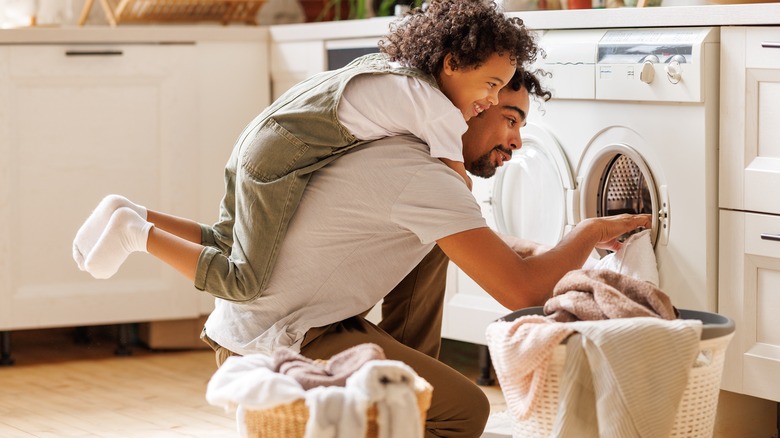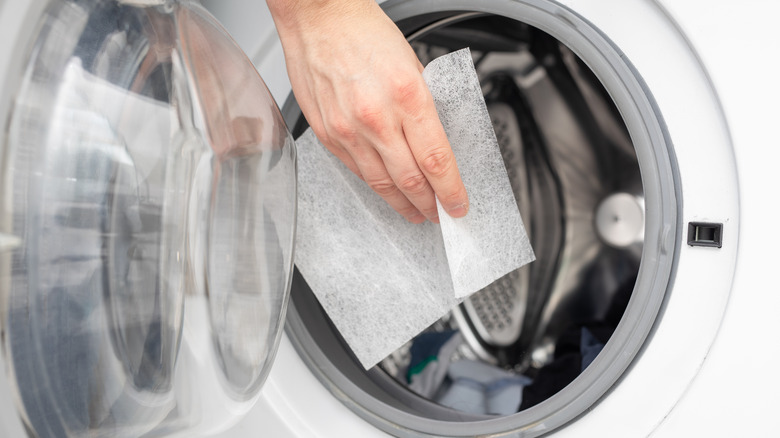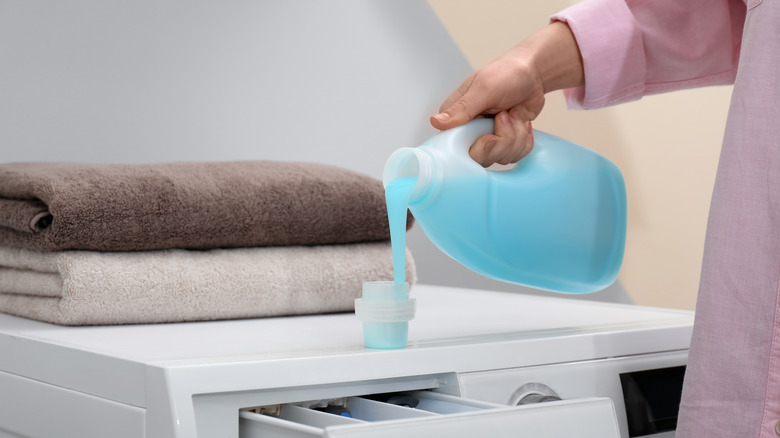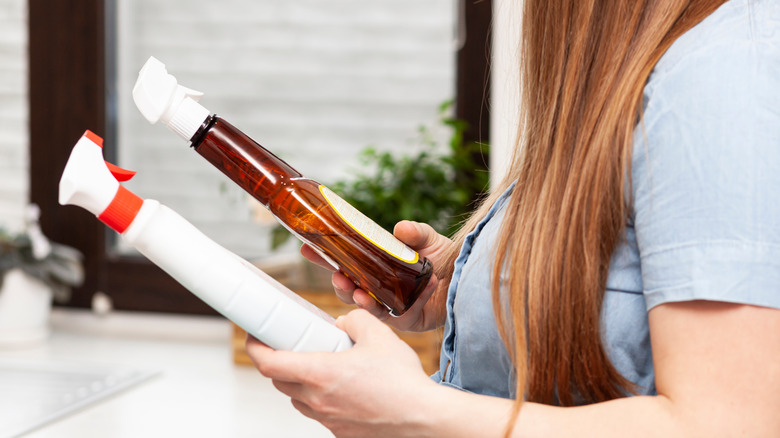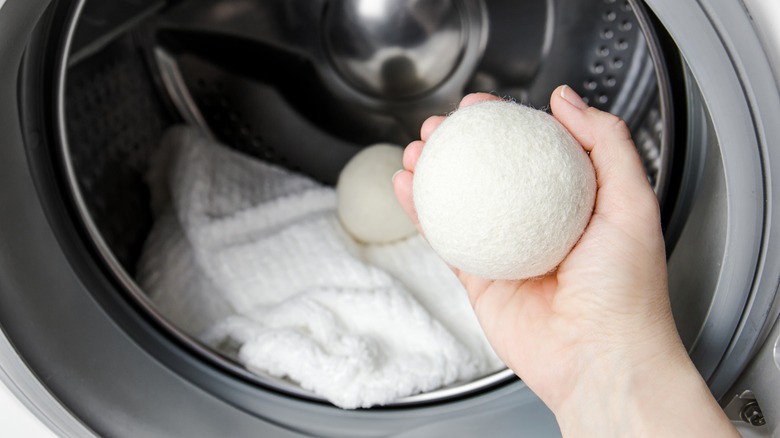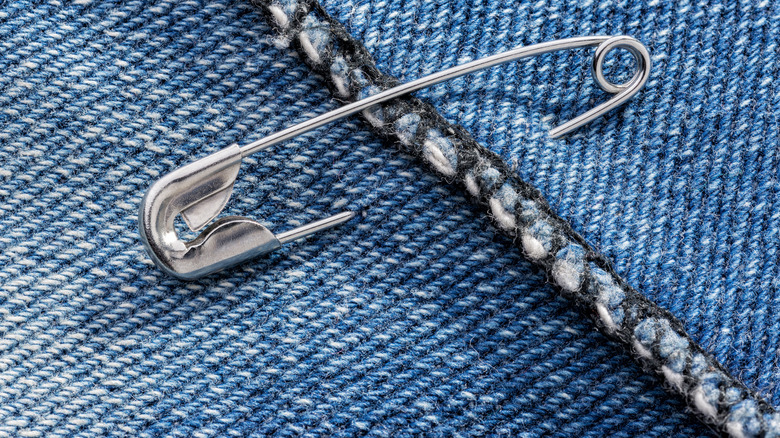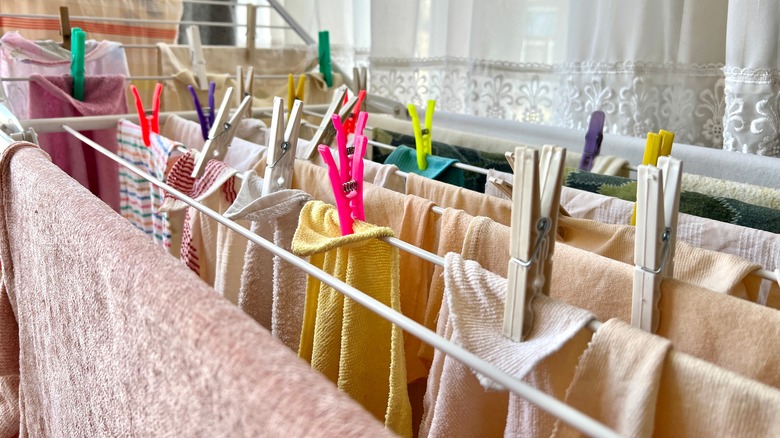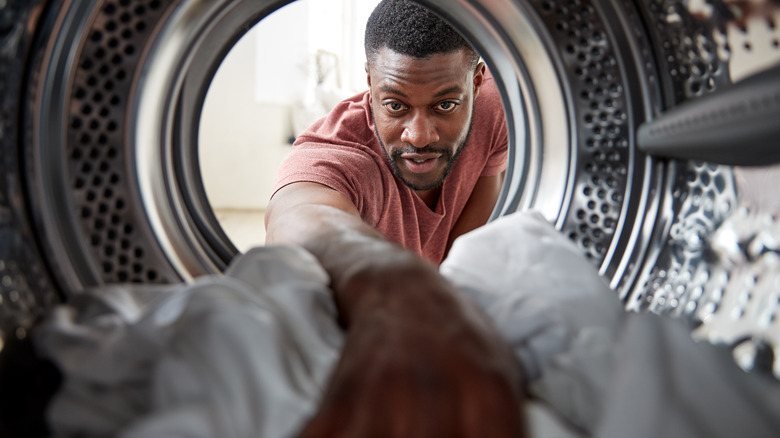How To Get Rid Of Static Cling In Your Laundry
Static cling can be a real nuisance. Dealing with several clothing items sticking to one another as you're trying to fold a load of laundry makes the whole process take longer. Smaller items, such as socks, can get trapped on other clothing items. They may either get lost in a drawer or remain stuck in your pants or shirt when you put them on. According to Label Planet, static cling is caused by electrical charges that are not balanced.
When clothing items rub against each other in the dryer, their electrons may move back and forth between the two pieces. If one piece ends up with an extra electron, it will have a negative charge. The other piece will have more protons than electrons, giving it a positive charge. Just as magnets with opposite charges will be attracted towards one another and pull together, the same is true for clothing items with opposite charges. Understanding what causes static cling is just the first step; keep reading to learn how to get rid of it and prevent your laundry from sticking together.
Use dryer sheets
Adding dryer sheets to each load of laundry before you start the dryer can help reduce static cling. Biokleen shares that dryer sheets have a fabric softener coating, which is positively charged. As the various fabrics in the dryer move around and come into contact with the dryer sheet, some of the positively charged ions are transferred to the clothing. This effectively absorbs static electricity and prevents your clothes from clinging to one another once the load is finished. In addition to reducing static cling, dryer sheets can also help soften clothes. The smooth coating they leave behind can also help prevent hair and other small debris from accumulating on the surface.
However, while dryer sheets can reduce static cling, there are a few reasons to think twice before using them with all your laundry loads. According to Appliance Center, some household members may be sensitive to the fragrances on the sheets, which can lead to rashes or breakouts. Using dryer sheets also increases waste, as you'll need a new one for each load of laundry. Moreover, the coating that helps prevent static cling isn't good for some fabrics or the inside of the dryer. For example, it can negatively impact how absorbent towels are, ruin the sweat-wicking properties of gym clothes, and damage silk.
Use fabric softener
Adding fabric softener to a wash cycle can also help reduce static cling. Liquid fabric softener coats your clothes' fibers during a wash cycle, but isn't entirely rinsed out. Once you pop the load into the dryer, its presence gives your clothes a positive charge, preventing static build-up, much like dryer sheets.
Oh So Spotless shares that using fabric softener will also leave clothes smoother and prevent them from feeling too stiff after washing. It can also minimize wrinkles and, in some cases, prevent pilling or fading. However, you shouldn't add fabric softener to every load. As with dryer sheets, it can reduce the absorbent properties of towels and cancel out the flame-retardant features of children's pajamas. Fabric softeners also shouldn't be used with water-resistant, microfiber, or synthetic materials, as it can affect their ability to absorb sweat or other liquids.
Try an anti-static spray
As their name suggests, anti-static sprays are designed to be sprayed on clothing to prevent static cling. The Portable Laundry shares that when you spray clothing, these products dispense electrons over the entire surface of a garment. This works as a barrier, preventing electrons from one clothing item from transferring to another, which is what can give clothes that negative charge.
There are different types and brands of anti-static sprays available. Before purchasing one to try, it is a good idea to check the ingredient list to avoid products with harmful chemicals. When possible, opt for a natural spray that will not threaten your health or the environment.
In addition to purchasing an anti-static spray, you can also try to use ingredients you likely already have around the house. Mixing water with vinegar following a ratio of 4 parts water to 1 part vinegar and spraying clothes before drying them can help decrease static cling.
Use dryer balls
If you're not already using dryer balls, adding them to your laundry routine may help eliminate static cling. According to Everyday Cheapskate, wool dryer balls are a healthier and more environmentally-friendly alternative to fabric softener and dryer sheets. Adding dryer balls to a load of laundry separates the fabrics as they dry, allowing more air to circulate. This can reduce the total time each load takes to dry and leave clothes feeling softer.
While some people say that wool dryer balls don't do as good of a job removing static cling as fabric softener or dryer sheets, there is a simple workaround. Static cling is often the result of clothes getting over-dried. Spritzing wool dryer balls with water before putting them in with a load of laundry allows the clothes to dry faster than the wool. Because the wool is still wet, it adds some humidity to the dryer, working to reduce static electricity.
Increase indoor humidity levels
Have you noticed that static cling seems worse in the winter? WUSA9 explains that this is because the air is colder and drier during the winter months. Lower humidity levels mean less water vapor in your home's air, which allows clothing items to hold a stronger charge.
Using a humidifier can help increase the indoor humidity level, putting more water vapor in the air. Sleepopolis explains that there are two main categories of humidifiers: cool mist and warm mist. Cool mist humidifiers — which may be either evaporative or ultrasonic — blow water vapor or droplets into the air to increase moisture levels. On the other hand, warm mist humidifiers disperse steam into the air by boiling water. In addition to reduced static cling, you may notice that a humidifier helps keep your skin, throat, lips, and nose from drying out as much as they typically do during the winter.
Use safety pins or a wire hanger
Metal can attract a static charge and remove it from clothing items. In God's Economy shares how adding safety pins to a load of laundry can help. When you put safety pins on an old sock before starting the drying cycle, they'll effectively work as a lightning rod, pulling the static charge from clothing. According to The Mama's Girls, you can also attach a safety pin to an inconspicuous spot on a piece of clothing that you're wearing to help release the static. Try pinning it to the inside of a hem or waistband.
Hello Homestead notes that wire hangers are also an effective static-removing tool. If the clothes you're wearing seem to be sticking to each other or clinging to your body, try passing a wire hanger over the garment. Doing so works to transfer the static from the item to the metal wire, eliminating the annoying cling.
Line dry your clothing
As shared above, static cling results from clothes rubbing against each other in the dryer. Clean Laundry shares that line drying your clothing — particularly the items that seem more prone to static cling — can therefore eliminate the problem of static cling. They also note that adding a little fabric softener to the wash cycle will deliver better results, even with line drying.
In addition to helping reduce static cling, line-drying your clothing can minimize wrinkles and make ironing less necessary. Line drying in the sun is also an effective solution for keeping white garments bright and white and for removing stains from garments. If you're interested in line drying your clothes to reduce static cling, you'll need the right tools. Depending on where you plan to line dry your garments, these may include a clothesline, clothespins, a drying rack, and hangers. Keep in mind that some fabrics — such as wool or knitted items — should be laid flat instead of hung up to dry. Hanging can cause them to stretch.
Do not overdry fabrics
Running the dryer longer than necessary can increase static electricity. Diversey notes that when fabrics in the dryer are still damp, the electrons that are transferred between fabrics will be able to return back to their original garment. However, as the garments dry, more static will build up. As the dryer continues to run, the garments will continue rubbing against one another, transferring more electrons and increasing the static charge.
If you promptly stop the dryer once each load is dry, fewer electrons will continue to transfer between garments, decreasing the amount of static cling. You can also reduce the amount of electricity if you avoid overloading the dryer. When the dryer is too full, the warm air doesn't effectively circulate through the entire load. This means that the clothes on the outside will dry more quickly than those in the center. While the clothes in the center of the dryer are still damp, those on the outside will be completely dry, allowing them to transfer more electrons and develop a strong static charge.
